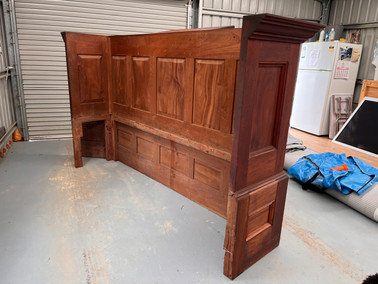“Heritage Renovation: What We Learned (and who helped us learn it)"
- Bridgit

- Jul 29
- 3 min read
Restoring a 140-year-old church isn’t for the faint-hearted. It is for the detail-obsessed, the patient, and those willing to listen to old buildings and the people who know how to work with them.
This blog is about what we’d do differently next time. Yes, there were many sleepless nights and fretful regrets and NO, there won't be a next time but for the sake of this blog, humour us for now.
It’s also about the extraordinary people who helped us get it right.
Lessons Learned (The Harder Way)
• There is no such thing as a ‘quick’ fix in heritage. If something looks straightforward, there’s probably a reason no one’s done it yet. We learned to take our time, ask more questions, and dig deeper. Sometimes literally.
• Do your homework. Or, in our case, eventually do your homework. Heritage rules are complex, but they’re not there to trip you up. They exist to protect the stories that buildings carry. Once we understood the intent behind them, everything made more sense. Ensure either you or your design/architects reference the Burra Charter.
• Be honest about your budget. Brutally honest and then double it. If you come in under - you will be lucky! Beautiful old buildings don’t give up their secrets easily, and every one of them costs money.
• Preservation doesn’t mean perfection. We learned to let the character stay. Slight irregularities, patched-over joins, a hand-carved beam or two with a past — these things don’t need replacing. They need respecting.
Tips for Navigating a Heritage Renovation (On Purpose Next Time)
• Talk to heritage officers early. They are not the enemy. Ours helped steer us through with more support than red tape.
• Hire people who know what they’re doing. Heritage experience does matter. We were lucky to work with craftspeople who didn’t just do a job. They left a legacy.
• Lean into the quirks. Not everything needs to be polished or modern. The charm lies in the uneven floorboards, the patchworked timbers, the way the light catches in restored glass.
• Document everything. Photos, receipts, samples, before-and-afters. We’ve become accidental archivists, and we’re glad of it.
Some of the extraordinary people who helped us get it right
Some trades left such a mark, we can’t imagine this project without them. A heartfelt thanks to:
🪵 Round 2 Timbers: For taking our tired old floorboards and joists, machining them (once we had de-nailed them), and giving them new life with care and craftsmanship. The tongue-and-groove finish is both beautiful and faithful to the building’s era.
🪟 Thermawood: Auerlio from the Newcastle branch - he restored every window (bar the memorial) with surgical precision. Over 3,000 solder points, 1,358 glass pieces cleaned and recut, and double glazing that doesn’t compromise the original look. He didn’t just repair the windows, he future-proofed them.
🪚 Wayne Mavin, Joiner: Wayne’s craftsmanship quietly shines from the front door to the mezzanine. He created the mezzanine handrails using original church joists, bringing elegance and strength to a new space - old timber, new purpose, timeless result. Wayne also designed and built the new front door, carefully matching it to the building’s original architecture and window forms. It’s a perfect welcome, solid, respectful, and beautifully in keeping with the church’s character. Every detail reflects the hands of a true master.
🛠️ Three of A Kind Furniture Craftsmen: For bringing the kitchen, bathroom, and breakfast bar to life using reclaimed and new materials in perfect harmony. The breakfast bar, made from the original red cedar pulpit, is both functional and quietly reverent. A masterful reinterpretation of sacred timber.
🔨 Our builder: His experience in heritage work guided us through some of the trickiest rebuilds, always with calm and clarity and always a story and a joke. From restoring structural integrity to supporting new design ideas, his steady hands made many things possible.
🖌️ Local trades: Carpenters, painters, plasterers, tilers and others who took the time to match old finishes, asked questions when unsure, and treated the church with the same reverence we did.
Final Thought
Heritage renovation can feel like a mountain. But with the right people around you, the right questions asked early, and the willingness to stay curious, it becomes a journey worth taking.
Our advice: Start slow. Listen well. Surround yourself with people who respect the past as much as you do. Because when it works, you’re not just restoring a building. You’re stitching stories back into place, one timber, one tile, one solder point at a time.
In the final Blog in this series we will cover:
One year on - reflections post completing a Heritage Renovation
Photo Credits - Nicole Macpherson






























Comments